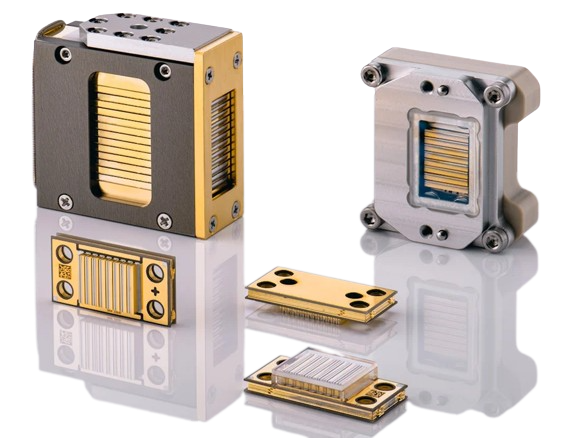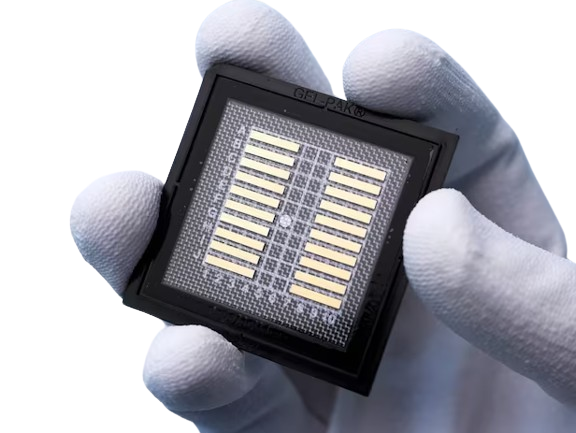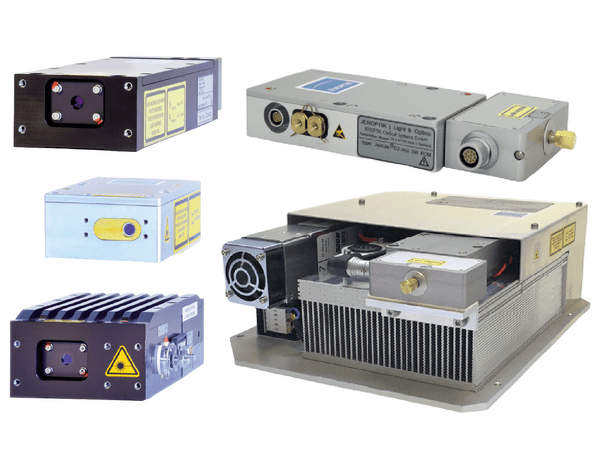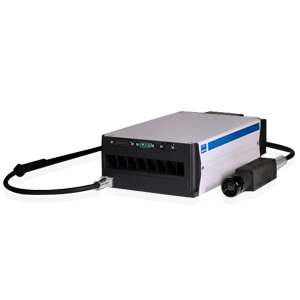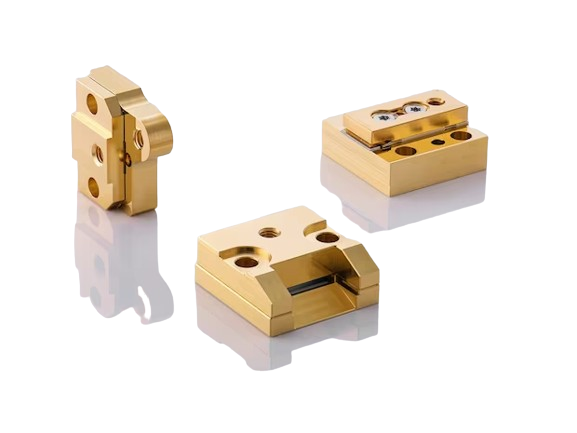JOLD-Stacks
Laser Diode, Multimode, Bar stack, Infrared, 760-1070nm, up to 2400W
Key Features:
- Scalable output power up to 2400W
- CW & QCW configurations
- High reliability & long lifetime
- FAC or FAC/SAC collimation lensing options
- Passive & active cooling options
- Fully customizable solutions
Get help selecting the right configuration for you!
If you do not see exactly what you need, please contact us!
The JOLD–Stacks Series offers a highly modular approach for power scaling well into the kW range. The series features compact, lightweight, and robust multimode, free-space laser diode stacks with options for 760-1070 nm, CW & QCW operation, output power up to 2400 W (QCW), no lensing or FAC or FAC/SAC collimation, active or passive cooling, and are completely customizable. JOLD-Stacks achieve optimal beam quality by reducing the stack pitch without compromising cooling capacity, and our proven hard-solder technology and strictly monitored production processes ensure tried & tested reliability in the harshest environments.
Your OEM Laser Diode Solution Awaits!
Many configuration options available:
- Wavelength: Options from 760-1070 nm (multi-wavelength stacks available for “color mixing”)
- Optical output power: number of bars per stack
- Operating mode: CW or QCW/long-pulse
- Cooling: active with DI or tap water or passive/conductive
- Packaging: with or without housing and protective window option
- Lensing: FAC or FAC/SAC lensing available
Passively Cooled Stacks:
QCW- and long-pulse configurations utilize vertical stacks made up of CTE-matched submounts on Direct-Copper-Bonded (DCB) substrates. This type of vertical stack clearly offers several advantages:
- Tap water or passive cooling of the DCB
- Light-weight
- Small footprint
- Compact multi-stack arrangements offering additional power scaling (multi-stack packages)
- Ideal for Medical applications like laser-based therapy for ophthalmology, dermatology, and esthetics
Passively Cooled QCW Stack Examples
Other wavelengths, heat sink variants, and configurations upon request. Let us know what you need!
| Wavelength (nm) | Output Power (W) | Operation Mode | Cooling | Collimation | Datasheet |
| 808 | 1560 | QCW | Passive | Fast axis | JOLD-1560-QAF-2x8A-med |
| 808 | 1600 | QCW | Passive | Without | JOLD-1600-QA-2x8A-med |
| 808 | 2160 | QCW | Passive | Without | JOLD-2160-QF-8A |
| 808 | 2400 | QCW | Passive | Without | JOLD-2400-Q-8A |
| 808 | 2400 | QCW | Passive | Without | JOLD-2400-QA-8A-industry |
| 940 | 2160 | QCW | Passive | Without | JOLD-2160-QF-8A |
| 940 | 2400 | QCW | Passive | Without | JOLD-2400-Q-8A |
| 940 | 2400 | QCW | Passive | Without | JOLD-2400-QA-8A-industry |
Let us help choose the right configuration for YOU!
Actively Cooled Stacks:
Microchannel-cooled packages (MCCP) which are actively cooled with DI water for CW-operation, utilizing best-known practices regarding microchannel designs, DI-water specification, and cooling circuit maintenance, enabling package-limited lifetimes > 10k hours – relevant for industrial applications:
- DI-water cooling for MCC packages
- Light-weight
- Small footprint
- Compact multi-stack arrangements offering additional power scaling (multi-stack packages)
- Ideal for Material Processing & DDL applications like welding, soldering, hardening, and annealing
Actively Cooled CW Stack Examples
Other wavelengths, heat sink variants, and configurations upon request. Let us know what you need!
| Wavelength (nm) | Output Power (W) | Operation Mode | Cooling | Collimation | Datasheet |
| 808 | 360 | CW | Active | Fast axis | JOLD-360-CAFN-8A |
| 808 | 400 | CW | Active | Without | JOLD-400-CANN-8A |
| 808 | 576 | CW | Active | Fast axis | JOLD-576-CAFN-8A |
| 808 | 600 | CW | Active | Without | JOLD-600-CANN-12A |
| 808 | 640 | CW | Active | Without | JOLD-640-CANN-8A |
| 808 | 800 | CW | Active | Without | JOLD-800-CANN-10A |
| 808 | 960 | CW | Active | Without | JOLD-960-CANN-12A |
| 940 | 440 | CW | Active | Fast axis | JOLD-440-CAFN-4A |
| 940 | 480 | CW | Active | Without | JOLD-480-CANN-4A |
| 940 | 660 | CW | Active | Fast axis | JOLD-660-CAFN-6A |
| 940 | 720 | CW | Active | Without | JOLD-720-CANN-6A |
| 940 | 1080 | CW | Active | Fast axis | JOLD-1080-CAFN-12A |
| 940 | 1200 | CW | Active | Without | JOLD-1200-CANN-12A |
Let us help choose the right configuration for YOU!
Benefits:
- Modular Power Scaling:
- Vertical stacking of individual sub-mounts within multi-laser-bar packages
- Highly modular approach for power scaling well into the kW-range
- Flexibly scale-up a laser stack to the requested power level at a given center wavelength
- Optimized Beam Quality:
- Beam quality (beam-parameter-product, BPP) optimized with lowest pitches
- Neighboring stack distance approaching 1.0 mm without compromising on cooling capacity of the submounts
- Proven Reliability:
- Tried & tested under application-specific conditions ranging from medical, industrial to mission-critical end use
- Proven hard-solder technology that covers even the harshest environmental conditions
- Strictly monitored production in clearly defined processes based on certifications
- Customization and Design Flexibility for Comprehensive Solutions:
- Tailored solutions to meet your unique application requirements
- Reliable laser solutions, providing you with the specifications you need
- From wafer to component, module, and beyond – let us know what you need!
Don’t hesitate to ask us anything!
| Wavelength (nm) | |
|---|---|
| Description | Laser Diode, Multimode, Bar stack, Infrared, 760-1070nm, up to 2400W |
| Type |


 SHIPS TODAY
SHIPS TODAY 